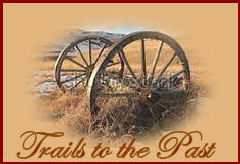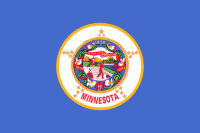|
Progressive Men
Index
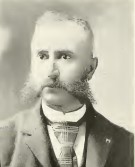 CHARLES WAYLAND DREW Among the many from the
Green Mountain state who have contributed to the
development of Minnesota is Charles W. Drew, of
Minneapolis.
Dr. Drew was born at Burlington, Vermont, on
January 18, 1858. His father Homer C. Drew, was a
contractor and builder in moderate circumstances. Both
parents were from old New England stock and had lived in
the state of Vermont for several generations. CHARLES WAYLAND DREW Among the many from the
Green Mountain state who have contributed to the
development of Minnesota is Charles W. Drew, of
Minneapolis.
Dr. Drew was born at Burlington, Vermont, on
January 18, 1858. His father Homer C. Drew, was a
contractor and builder in moderate circumstances. Both
parents were from old New England stock and had lived in
the state of Vermont for several generations.
Dr.
Drew was educated in the public schools of
Burlington and in the University of Vermont, which he
entered at the age of fifteen. The natural bent of his
mind was toward the sciences, especially chemistry, and
during the four years at the University a large share of
his time was devoted to this and kindred studies. He
graduated in 1877 and received the degree of Bachelor of
Philosophy and an election to the honorary Phi Beta
Kappa Society. Following his graduation about eighteen
months were spent in work and study in various
laboratories in New York and Brooklyn, and afterward he
became a student in the Medical Department of the
University of Vermont. He graduated in 1880 and received
the highest honors in a class of about sixty, taking the
degree of Doctor of Medicine, the first prize for
general proficiency and also the prize for the most
meritorious thesis. The year following graduation was
spent in Brattleboro, Vermont, in association with one
of the best known physicians in the state, and at the
end of which time Dr. Drew came to Minnesota and soon
established himself in medical practice in Minneapolis.
In the following year he was appointed as
Professor of Chemistry in the Minnesota Hospital
College, and continued in that position for seven years,
when the school was merged with others to form the
Medical Department of the State University. In 1883 Dr.
Drew was appointed City Physician. In 1886 he made an
exhaustive investigation of “Food Adulterations in
Minnesota,” and published a monograph upon the subject,
and in the same year he was appointed State Chemist to
the Dairy and Food Department. This position he held for
six years, during that time doing a large amount of work
among the lines of chemistry of foods and sanitary
chemistry in general. He established, in 1886, a private
school of pharmacy under the name of the Minnesota
Institute of Pharmacy, which school is still in
existence and has been attended by more than seven
hundred students. At the present time, of all the
legally qualified pharmacists in the state, twenty-five
percent have been its students.
Dr. Drew was appointed in 1895 as chemist to the
City of Minneapolis, a position which he still holds.
His medical practice was discontinued in 1889, his time
since then being fully occupied in his various lines of
chemical investigation and in teaching. His work in
chemistry covers a wide field, and owing to his high
professional standing and wide reputation as a chemist
he is frequently called to different parts of the
Northwest as an expert in this branch of science and in
Chemico-legal and Toxicological lines. In politics Dr.
Drew has always been a Republican, but though he has
taken an active part in the affairs of his party, all
positions which he has held have been of a professional
character.
He has been a member of various professional
societies, including the Minnesota Medical Society, the
Hennepin County Medical Society, the American Medical
Association, the American Chemical Society and others.
He was made a Mason in Washington Lodge, No. 3,
Burlington, Vermont in 1870 afterward affiliated with
Khurum Lodge, Minneapolis, which he left to become a
charter member of Minnehaha Lodge, of which he is Past
Master. He is at present a member of Ark Lodge, No. 176.
He is also a member of St. John’s Chapter,
R. A. M., of Zion Commandery, Knights Templar, and of
Zuhrah Temple of the Mystic Shrine.
He attends the Episcopal Church, but is not a
member. He was married on September 18, 1884, in
Brattleboro, Vermont, to Annah Reed Kellogg, daughter of
Henry Kellogg, of Boston, Massachusetts. They have two
children, Julia Kellogg, born in August, l890, and
Charles Wayland, jr., born in June.
1896.
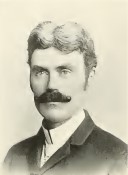 JAMES HENRY DUNN Dr. Dunn is a physician and
surgeon in Minneapolis, the son of James and Mary O’Hair
Dunn, of Dublin, Ireland. James Dunn was a merchant who
failed in 1845 and emigrated to America. He served in
the Mexican war and located in Indiana. Subsequently he
removed to Minnesota, and in 1854 took a farm in Winona
County on a soldiers’ warrant. JAMES HENRY DUNN Dr. Dunn is a physician and
surgeon in Minneapolis, the son of James and Mary O’Hair
Dunn, of Dublin, Ireland. James Dunn was a merchant who
failed in 1845 and emigrated to America. He served in
the Mexican war and located in Indiana. Subsequently he
removed to Minnesota, and in 1854 took a farm in Winona
County on a soldiers’ warrant.
The subject of this sketch was born at Fort
Wayne, Indiana, May 29, 1853. He lived on his father’s
farm till he was fifteen, and received his early
education in the common and higher schools of Winona
County. He entered the state normal school at Winona
where he graduated in 1872. He took private instruction
in the modern languages, studied medicine at Rush
Medical College and was graduated from the medical
department of the University of New York City, March,
1878. He
was instructor in the second state normal school in 1878
and 1879, and engaged in general medical practice till
1883. He then went abroad to pursue his studies, and in
1884 and 1885 took post-graduate studies, in the German
universities of Heidelberg and Vienna giving his special
study to such medical branches as at that time were, in
default of laboratories here, more successfully taught
in Europe than in America. A short observation of French
practice was made during a summer in Paris. He also took
a short tour of Italian hospitals.
On his return to America he located in
Minneapolis, where he has since practiced his
profession. He was elected city physician in 1887 and
1888, and organized the first city hospital. He has been
surgeon in charge of St. Mary’s Hospital since its
foundation in 1887, and surgeon to Asbury Hospital since
1884. He is consulting surgeon of the Great Northern
Railway Company, professor of genitourinary and adjunct
professor of clinical surgery in the University of
Minnesota.
His practice, though at first general, has become
especially surgical, genitourinary and consulting, Dr.
Dunn having become one of the most prominent consulting
practitioners in the Northwest. His ambition is
to excel in the great art of clinical diagnosis and
surgical technique, rather than to pursue special and
original researches, though many experimental studies to
confirm or refute new medical and surgical theories have
been pursued. For example, some disputed in Minnesota, a
study of one hundred and fifty four cases published in
1888, experimental work in abdominal surgery and an
original application of a suprapubic cystotomy for
cancers of the urethra (Annals of Surgery, 1894.) a new
method of tenotomy is now in preparation. Dr. Dunn is a
teacher, a student, investigator and practitioner of
that which has been discovered and believed, rather than
one absorbed in the new to the exclusion of the
old. He has
had a wide experience and large success with all
established procedures of general surgery, and is
conservative in adopting the new and little-tried
measures until their value and usefulness have been
proven.
He is a member of the Minneapolis
Club, the State Historical Society, the Minnesota State
Medical Association, and an ex-president of the latter,
the Minnesota Academy of Medicine, the American Medical
Association, the Association of American Obstetricians
and gynecologists, and is a frequent contributor to
various medical and surgical journals. Dr. Dunn has one
of the largest private libraries in the Northwest,
especially complete in new and old literature of
American, English, French and German surgical
authorities. He was married in 1885 to Agnes, daughter
of Hon. J. L. Macdonald, formerly judge of the Third
Judicial District, now practicing attorney of St. Paul.
They have one child, James L., aged eight
years.
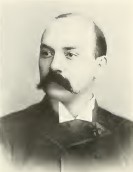 FREDERICK A.
DUNSMOOR is an eminent physician, surgeon and
gynecologist practicing his profession at Minneapolis.
Dr. Dunsmoor is a native of Minnesota, and was born May
28, 1853, at Richfield, in Hennepin County, the son of
James A. and Almira Mosher Dunsmoor. His parents were
natives of Maine, and came to Hennepin County,
Minnesota, in 1852. Frederick Alanson received his
education in the public schools of Richfield,
Minneapolis and at the University of Minnesota.
His professional training began in the office of
Doctors Goodrich and Kimball, of Minneapolis, and was
continued in the Bellevue Hospital Medical College, New
York city, where he received the degree of M. D. in
March, 1875. He also received private instruction from
Doctors Frank H. Hamilton, Alfred G. Loomis, Austin
Flint, Sr., E. G. Janeway and R. Ogden
Doremus. He began his practice at Minneapolis in
partnership with Dr. H. H. Kimball, and
was associated with him one year. Dr. Dunsmoor has been
active in hospital work, having assisted in the
establishment of the Minnesota College Hospital in 1881,
and serving as vice president and dean of the medical
college, professor of surgery and attending surgeon to
the hospital and dispensary for eight years. In 1889 the
Hospital College, in conjunction with other schools of
medicine in St. Paul and Minneapolis, was reorganized in
the medical department of the University of Minnesota. FREDERICK A.
DUNSMOOR is an eminent physician, surgeon and
gynecologist practicing his profession at Minneapolis.
Dr. Dunsmoor is a native of Minnesota, and was born May
28, 1853, at Richfield, in Hennepin County, the son of
James A. and Almira Mosher Dunsmoor. His parents were
natives of Maine, and came to Hennepin County,
Minnesota, in 1852. Frederick Alanson received his
education in the public schools of Richfield,
Minneapolis and at the University of Minnesota.
His professional training began in the office of
Doctors Goodrich and Kimball, of Minneapolis, and was
continued in the Bellevue Hospital Medical College, New
York city, where he received the degree of M. D. in
March, 1875. He also received private instruction from
Doctors Frank H. Hamilton, Alfred G. Loomis, Austin
Flint, Sr., E. G. Janeway and R. Ogden
Doremus. He began his practice at Minneapolis in
partnership with Dr. H. H. Kimball, and
was associated with him one year. Dr. Dunsmoor has been
active in hospital work, having assisted in the
establishment of the Minnesota College Hospital in 1881,
and serving as vice president and dean of the medical
college, professor of surgery and attending surgeon to
the hospital and dispensary for eight years. In 1889 the
Hospital College, in conjunction with other schools of
medicine in St. Paul and Minneapolis, was reorganized in
the medical department of the University of Minnesota.
Dr. Dunsmoor served as
professor of surgery in the St. Paul medical college in
1877 and till 1879, in the medical department of Hamline
University 1879 to 1881, Minneapolis Hospital College
from 1881 to 1888, and in the medical department of the
University since its organization. He was county
physician for Hennepin County during 1879. He was also
active in organizing Asbury Methodist Hospital, which
was opened September 1, 1892, and which became the chief
clinical field for the medical department of the
University and of the College of Physicians and Surgeons
of Minneapolis. Dr. Dunsmoor has also been in active
service as surgeon to St. Mary’s Hospital since 1890, to
St. Barnabas Hospital since 1879, gynecologist to the
City Hospital since 1894, to the Asbury Hospital since
1892, to the State Free Dispensary since 1889, and to
the Asbury Free Dispensary since 1889. He has devoted
his attention to surgery and gynecology, operating every
morning, and enjoys a wide reputation as a skillful and
successful operator. For many years his
services have been in demand by the railway, milling,
accident and insurance companies.
Dr. Dunsmoor is a member of a
number of professional and scientific societies, among
them the International Medical Congress, the North
Dakota State Medical Society, The American Medical
Association, the National Association of Railway
Surgeons, the Minnesota Academy of Medicine, the
Minnesota State Medical Association, the Hennepin County
Medical Society and the Society of Physicians and
Surgeons of Minneapolis. His membership in social and
beneficiary societies includes the Nu Sigma Nu Society,
the Masonic order, the Good Templars, the Druids, the
Minneapolis Club and the Commercial and Athletic Club of
the latter two he was a charter member. He is also an
active member of the Hennepin Avenue Methodist church,
where he has served for years in an official capacity.
He is a diligent student of the science of medicine and
surgery, and spends a portion of each winter in medical
study in some of the great scientific centers, and
enjoys the acquaintance of and professional association
with the most famous surgeons in the country.
He is a contributor to different
medical and surgical journals, and is recognized as
authority in his particular branch of the practice. He
is a man of genial manners and happy temperament, and an
enthusiastic patron of music and the fine arts.
Dr. Dunsmoor was married September 5, 1876, to
Miss Elizabeth Emma Billings, daughter of the late
Surgeon George E. Turner, U. S. A.
They have three children living, Marjorie
Allport, Elizabeth Turner and Frederick Laton.
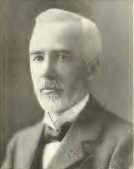 WILLIAM HOOD
DUNWOODY, who has long been identified with the flour
milling interests of Minneapolis, is a native of
Pennsylvania. He was born in Chester County, on March
14, 1841. His father was James Dunwoody, whose father,
grandfather and great grandfather lived in the same
vicinity in Chester County and were all engaged in
agricultural pursuits. The family is of Scotch ancestry.
Mr. Dunwoody’s mother was Hannah Hood, the daughter of
William Hood, of Delaware County, Pennsylvania, whose
ancestors came to this country when William Penn founded
the colony which took his name. WILLIAM HOOD
DUNWOODY, who has long been identified with the flour
milling interests of Minneapolis, is a native of
Pennsylvania. He was born in Chester County, on March
14, 1841. His father was James Dunwoody, whose father,
grandfather and great grandfather lived in the same
vicinity in Chester County and were all engaged in
agricultural pursuits. The family is of Scotch ancestry.
Mr. Dunwoody’s mother was Hannah Hood, the daughter of
William Hood, of Delaware County, Pennsylvania, whose
ancestors came to this country when William Penn founded
the colony which took his name.
Mr. Dunwoody’s early life was
passed upon the farm where he was born. After a period
of schooling in Philadelphia, he at the age of eighteen,
entered his uncle’s store in Philadelphia, and commenced
what proved to be the business of his life. His uncle
was a grain and flour merchant. After a few years Mr.
Dunwoody commenced business for himself as a senior
member of the firm of Dunwoody & Robertson. After
ten years of practical experience in Philadelphia flour
markets, Mr. Dunwoody came to Minneapolis in 1869, and,
for a time, represented several eastern houses as flour
buyer. Milling at Minneapolis was then in a state of
transition. It was the time when the old fashioned mill
stones were giving place to the modern steel rollers and
the middlings purifier.
With keen perception Mr. Dunwoody
saw that a great advance in the milling business was at
hand, and in 1871 he embarked in milling as a member of
the firm of Tiffany, Dunwoody & Co. He was also a
member of the firm of H. Darrow & Co., and
the business of both concerns was under his personal
management. Early in his career
as a Minneapolis miller Mr.
Dunwoody distinguished himself among his
associates by devising and organizing the Minneapolis
Millers” Association, which was for a long time a most
important organization, its object being co-operation in
the purchase of wheat throughout the northwest country.
It had an important part in the building up of the
Minneapolis milling business. Its work was discontinued
when the general establishment of elevators and the
development of the Minneapolis wheat market made it no
longer necessary for the millers to work in co-operation
in buying their wheat.
Another important work which Mr.
Dunwoody early attempted was that of arranging for the
direct exportation of flour. It had been the custom to
sell through brokers and middle men of the Atlantic sea
ports. In 1877 Mr. Dunwoody went to England and, though
he met with a most determined opposition, succeeded in
arranging for the direct export of flour from
Minneapolis, a custom which has since continued without
interruption. Shortly after the
great mill explosion of 1878 Governor C. C. Washburn
induced Mr. Dunwoody to join him in a milling
partnership with the late John Crosby, and Charles J.
Martin. The firm thus formed,
Washburn, Crosby & Co., continued for many years and
was succeeded by the Washburn, Crosby Co., a few years
since. Since Mr. Dunwoody’s connection with the Washburn
mills in 1871) he has been unintermittedly identified
with the conduct of this famous group of mills. It was
natural that Mr. Dunwoody, as a prominent miller, should
take a large interest in the management of
elevators. He has invested
largely in elevator properties, and was one of the
organizers of the St. Anthony & Dakota Elevator
Company, the St. Anthony Elevator Company, and the
Duluth Elevator Company. In addition to these interests,
Mr. Dunwoody holds other important interests, and is
connected with a number of the strongest financial
institutions of Minneapolis.
He is a director of the Northwestern National
Bank and also of the Minneapolis Trust Company. Before
coming to Minneapolis, Mr. Dunwoody married Miss Kate L.
Patten, the daughter of John W. Patten, a prominent
merchant of Philadelphia. Their home is a handsome
dwelling on Tenth Street at the corner of Mary Place.
Mr. Dunwoody’s refined tastes have been gratified in
late years by extensive
travel.
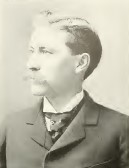 CHARLES B.
ELLIOTT. is one of the judges of the district court of
Hennepin County, and is now serving his second term in
that office. Judge Elliott is a native of Ohio. He was
born in Morgan County, January 6, 1861, the son of
Edward Elliott, a farmer of limited resources. His
ancestry is English, and settled in New England in the
early history of the country. Soon after the
Revolutionary War the town of Marietta, Ohio, was
founded, and Judge Elliott’s people were among its early
settlers. His education was commenced in the common
schools of Morgan County, and continued in the high
school of Pennsville, a Quaker village of that county. CHARLES B.
ELLIOTT. is one of the judges of the district court of
Hennepin County, and is now serving his second term in
that office. Judge Elliott is a native of Ohio. He was
born in Morgan County, January 6, 1861, the son of
Edward Elliott, a farmer of limited resources. His
ancestry is English, and settled in New England in the
early history of the country. Soon after the
Revolutionary War the town of Marietta, Ohio, was
founded, and Judge Elliott’s people were among its early
settlers. His education was commenced in the common
schools of Morgan County, and continued in the high
school of Pennsville, a Quaker village of that county.
Before the age of sixteen he had
qualified himself as a teacher, and after pursuing that
profession for a short time he entered the preparatory
Department of Marietta College. With the exception of
short intervals occupied in teaching, in order to earn
money to pay his expenses, he continued in school there
for three years. In the meantime his father removed to
Iowa, and Charles B. Elliott followed him and entered
the law department of the Iowa State University, from
which he graduated with a degree of LL. B., in 1881, at
the age of twenty years. He entered the law
office of Barnan & Jayne, at Muscatine, Iowa, where
he remained a year. During this time he had become a
contributor to the Central Law Journal, of St. Louis,
and his contributions were received with such favor that
in April, 1882, he was offered a position on the
editorial staff and removed to St. Louis. For eighteen
months he devoted his time to writing, for the Central
Law Journal, the Southern Law Review and the Western
Jurist. About this time his eyes began to fail him and
he was obliged to abandon his editorial work in St.
Louis and went to Aberdeen, South Dakota, where he
opened a law office and became the representative of the
Muscatine Mortgage and Trust Company.
January, 1885, found him in
Minneapolis engaged in the practice of law, and here he
pursued his profession until he was appointed judge of
the municipal court, January 15, 1890, by Governor
Merriam. During this time he also pursued a post
graduate course in history and international law for
three years at the University of Minnesota, from which
he received the degree of Ph.
D., in 1888. In 1892 he was re-elected to the
municipal bench by the largest majority given to any
candidate on his ticket, and served in that office until
January 4, 1894, when he was appointed judge of the
district court by Governor Nelson, to fill an unexpired
term. He was elected again to the district bench in the
fall of 1894, for a term of six years, and is now
serving in that capacity. He was lecturer in the college
of law at the University of Minnesota from 1889 to 1894,
and since September I, 1894, has been head of the
department of corporation and international law in the
same school.
Judge Elliott is a student and a
man of high attainments, and although now but
thirty-five years of age, has come to be recognized as
an authority on questions of international and public
law. He has written extensively on these subjects, and a
list of his writings fills two pages of the report of
the American Historical Association. Notable among his
works were, the treatise in 1888 on the United States
and the Northeastern Fisheries”; “Principles of the Law
of Private Corporations,” 1894; “Outline of the Law of
Insurance,” 1895, and a work on “International Law,” now
in press. His work in the Northwestern Fisheries is
regarded as the highest authority on that subject.
George Bancroft pronounced it “admirable, exact,
thorough and free from prejudice.” Henry Cabot Lodge
wrote: “It is the best and clearest history of the
question I have seen.” Political Science Quarterly
pronounced it “One of the most exhaustive articles on
this question.” Judge Elliott, while accomplishing so
much in his profession and as an author, has not been a
recluse, but has found time to mingle freely among men
and is held in high esteem by all, not only on account
of his intellectual qualifications, but also on account
of his social qualities. He is a Mason, Knight Templar,
a member of Zuhrah Temple, also a member of the I. O. O.
F. He belongs to the Congregational Church and takes an
active, practical interest in all current questions,
local as well as general. On May 13, 1884 he married
Edith Winslow, and has four children. He has recently
been complimented by the Iowa State University with the
honorary degree of LL. D.
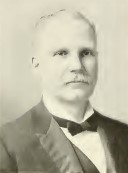 WILLIAM
HENRY EUSTIS, furnishes in his own career a good
illustration of the possibilities before a capable,
energetic and self-reliant young man in America. He is
the son of a mechanic, reared in the humble home of a
mechanic and destined by his parents for a mechanic’s
life. Unfortunately, and yet, perhaps, fortunately, a
severe affliction, the result of an accident, changed
his purpose in life from that of a mechanic, and opened
the door to a wider field for the development of his
talents and the employment of his faculties. Mr. Eustis
was born at the little village of Oxbow, New York, July
17, 1845. His father, Tobias Eustis, was a native of
Cornwall, England, and emigrated to America while a
young man and learned and followed the trade of a
wheelwright. His ancestors were
miners in Cornwall. His mother, Mary
Marwick, was also of English descent. WILLIAM
HENRY EUSTIS, furnishes in his own career a good
illustration of the possibilities before a capable,
energetic and self-reliant young man in America. He is
the son of a mechanic, reared in the humble home of a
mechanic and destined by his parents for a mechanic’s
life. Unfortunately, and yet, perhaps, fortunately, a
severe affliction, the result of an accident, changed
his purpose in life from that of a mechanic, and opened
the door to a wider field for the development of his
talents and the employment of his faculties. Mr. Eustis
was born at the little village of Oxbow, New York, July
17, 1845. His father, Tobias Eustis, was a native of
Cornwall, England, and emigrated to America while a
young man and learned and followed the trade of a
wheelwright. His ancestors were
miners in Cornwall. His mother, Mary
Marwick, was also of English descent.
William Henry was the second of a
family of eleven children, and at an early age
contributed to the family’s support by such employment
as he could pick up in the neighborhood, the chief of
which was grinding bark in the village tannery.
He was fifteen at the time of the accident above
referred to. His recovery was due largely to the strong
constitution, resolute will and the study which he gave
to his own case and the care he exercised in applying
the treatment. He eventually became able to teach
district school in the winter months and finally entered
the seminary at Gouverneur, St. Lawrence County. The
most his parents hoped at this time was that he might be
able to follow some lighter occupation, as, for
instance, shoe making or harness making.
But he had applied himself to learn
bookkeeping and telegraphy, and by the aid of these
prepared himself for a more complete literary
education. By teaching
bookkeeping and telegraphy and soliciting life insurance
he earned enough to pay his way through the seminary and
through his preparation for college. In 1871 he entered
the sophomore class of Wesleyan University, of
Middletown, Connecticut, and while absenting himself
during the winter in order to teach school kept up with
his class and completed his course in 1873. He then went
to New York and took the law course at Columbia Law
School, where he graduated in 1874, having accomplished
two years’ work in one. He was now ready for the
practice of his profession, but he was a thousand
dollars in debt. On account of this debt he procured a
position as teacher, and at the close of the year paid
the obligation and had money enough to buy a railroad
ticket to Saratoga Springs, a new suit of clothes and a
surplus of $15 with which to commence the work of his
life. At Saratoga he made the acquaintance of John R.
Putnam, who offered him a partnership, which he
accepted, and Mr. Eustis remained there in partnership
with Mr. Putnam for six years, sharing a large and
lucrative business.
In the spring of 1881 Mr. Eustis
sailed for Europe to be gone two years. He had taken an
active part in the convention of 1882 and stumped the
state of New York for Garfield. When the news of
Garfield’s assassination was received by him he was so
impressed by its significance that he felt obliged to
return home, and did so. Mr. Eustis had made up his mind
that the best field for success in life was to be found
in the West, and he set out on a prospecting tour,
including Kansas City, St. Louis, Dubuque and other
ambitious Western places, ultimately reaching
Minneapolis, which pleased him most, and here he settled
on the twenty-third of October, 1881. He commenced the
practice of law without a partner. He had brought with
him a small sum, the savings of his earlier years, and
by the judicious use of it has acquired considerable
property.
He built the brick block on Sixth
Street and Hennepin, the Corn Exchange and the Flour
Exchange, besides other less important structures. He
has always been identified with enterprises for the
advancement of the city, and is largely interested in
various industrial undertakings. He is one of the
original incorporators of the Minneapolis, Sault Ste.
Marie & Atlantic Railway, and one of Its board of
directors. He was a director and member of the building
committee of the Masonic Temple. He was one of the
originators of the North American Telegraph Company, a
director and its secretary, a line established to
furnish people of the Northwest with competition in
telegraphic service. He has been actively identified
with everything which is calculated to advance the
interests of the city.
In 1892 Mr.
Eustis was elected mayor of Minneapolis by the
Republicans, and his administration is frequently
referred to as the most notable in the history of the
city. He made a very careful study of the saloon
question and the laws relating to the liquor traffic at
the beginning of his term of office and sought to
enforce them in such a way as to secure the best
results. His theory of administration did not call for
the strictest enforcement of the law in accordance with
the letter, but for such enforcement as, while granting
more licenses to the saloon than the law specified,
sought to enlist the saloonkeepers in a general effort
for the suppression of crime and the diminution of
drunkenness. The statistics of the police department and
the workhouse for the two years of his administration
show that his theory was well founded. Drunkenness
diminished, commitments to the workhouse were cut down,
the sale of liquor to minors was noticeably reduced and
the evils resulting from the liquor traffic generally
minimized.
Mr. Eustis grew up under Methodist
influences, and is a member of the Methodist church. He
was never married, but occupies comfortable bachelor
quarters in his Sixth Street building and boards at the
West Hotel. He is the possessor of a fine library, and
derives much pleasure and enjoyment among his books. Mr.
Eustis is an orator of grace and power, and has rendered
invaluable services to his party in campaign work. He
was a delegate to the Republican National Convention in
1892, and voted for Blaine. His gift as a public speaker
makes him in great demand on public occasions, and he
has probably but one equal and no superior in the state
as a graceful after dinner speaker. He is a man of
genial manners and agreeable personality, and a welcome
guest on every public occasion.
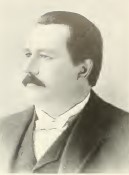 ROBERT GRENAP
EVANS, is a lawyer and leading member of the Minneapolis
bar. His ancestry is Welsh and English, but both his
parents were born in this country, in Kentucky.
His father, Joseph S. Evans, in the early ‘50’s,
while yet a young man, went from Kentucky to Indiana,
and located at Troy. He was first employed on a farm,
but afterwards engaged in mercantile business, having
removed to Rockport, Indiana, in 1856. He continued in
the mercantile business until 1874, except for a few
years, when he was engaged in farming. More recently he
has been in the insurance business at Rockport. At Troy
he married Mary C. Cotton, a daughter of a physician
practicing his profession in Indiana, and a member of
the constitutional convention which revised the
constitution of that state in 1852. ROBERT GRENAP
EVANS, is a lawyer and leading member of the Minneapolis
bar. His ancestry is Welsh and English, but both his
parents were born in this country, in Kentucky.
His father, Joseph S. Evans, in the early ‘50’s,
while yet a young man, went from Kentucky to Indiana,
and located at Troy. He was first employed on a farm,
but afterwards engaged in mercantile business, having
removed to Rockport, Indiana, in 1856. He continued in
the mercantile business until 1874, except for a few
years, when he was engaged in farming. More recently he
has been in the insurance business at Rockport. At Troy
he married Mary C. Cotton, a daughter of a physician
practicing his profession in Indiana, and a member of
the constitutional convention which revised the
constitution of that state in 1852.
Robert Grenap was born while his
parents resided at Troy, March 18, 1854. He attended the
village schools of Rockport until his eighteenth year,
when he entered the sophomore class of the state
university at Bloomington, and completed the junior year
in that institution. His inclinations were toward the
law as a profession, and in 1875 he entered the law
office of Charles L. Wedding, of Rockport,
and began his legal education, at the same time
practicing before the justice courts of Spencer County.
In 1876 he was admitted to the bar. He left Rockport
soon after and settled in Vincennes, where he formed a
law partnership with Judge F. W. Viehe, which continued
until April, 1884, when Mr. Evans came to Minneapolis.
In July of that year he formed a partnership with Judge
Daniel Fish, which continued until November, 1887, when
it was dissolved on account of the retirement of Judge
Fish from general practice to become the attorney of the
Minnesota Title Insurance Company.
Mr. Evans then formed his
present business connection with Messrs. A. M. Keith,
Charles T. Thompson and Edwin K.
Fairchild, under the firm name of Keith, Evans, Thompson
& Fairchild. This firm is regarded as one of the
strongest in the state, and enjoys an extensive and
lucrative practice of a general business character and
largely an office practice. Mr. Evans was
also the local attorney for the St. Paul, Minneapolis
& Omaha road from the time he came to Minneapolis in
1884 until January 1, 1895.
He is a Republican and has always
taken an active interest in politics, both in Indiana
and in Minnesota. He has never sought an office and has
never held one, but has done a great deal of valuable
and effective work for his party. He served on the state
central committee in Indiana for two years including the
campaign of 1880, but declined reappointment at the end
of the second year. He was in Minnesota when the
vigorous campaign of 1884 opened, and, although a new
arrival, he threw himself into the work of the campaign
with the same enthusiasm and devotion to the cause which
he has always manifested. He made a number of
speeches in that campaign and has stumped the state at
every general election since.
Mr. Evans is a man of rare
geniality, courteous in his treatment of everyone,
generous and sincere, and he is the trusted friend of
probably more public men than any other man of the
state. These qualities of good fellowship, kindliness
and square dealing in politics, are responsible for the
friendly familiarity which has caused him to be known
everywhere as “Job” Evans. Never asking for political
preferment for himself, he is always ready to sacrifice
his time and private interests to the good of his party
and the advantage of his political friends. He had been
in the state scarcely two years before he was selected
as a member of the Republican state central committee,
assisting in the conduct of the McGill campaign in 1886.
In December, 1887, Senator Davis resigned from the
National Republican committee and Mr. Evans was selected
to fill the vacancy. He was elected for the period of
four years again in 1888, and re-elected in 1892. He has
always been an active member of the Union League, and
was president of that organization in 1885 and 1886. He
is a member of the Commercial Club and the Minneapolis
Club, and an attendant of the Methodist Church.
He was married in 1877 to Mary Graham, at
Evansville, Indiana, and has three children living,
Margaret, Stanley and Graham. His home is in the suburb
of Kenwood.
The information
on Trails to the Past © Copyright
may be used in personal family history research, with
source citation. The pages in entirety may not be
duplicated for publication in any fashion without the
permission of the owner. Commercial use of any material
on this site is not permitted. Please respect the
wishes of those who have contributed their time and
efforts to make this free site possible.~Thank
you! |
